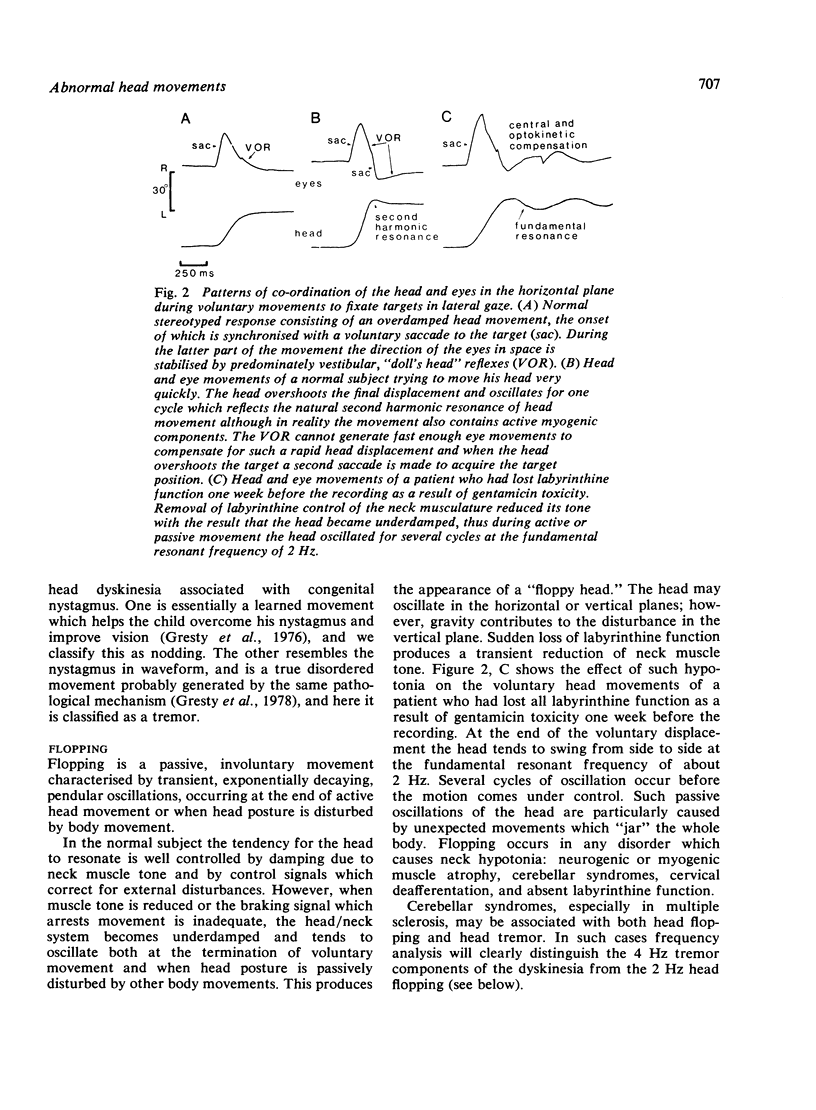Abstract
Abnormal head movements have been studied in a variety of diseases using objective recording techniques and the data analysed with respect to the frequency content of the movement. Flopping, nodding, tic, chorea, myoclonic jerks, and most head tremors involve frequencies of approximately 2 and 4 Hz which correspond to the natural fundamental and second harmonic resonances of the head as determined by the mechanical properties of the head/neck system. These findings provide a basis for classification of abnormal head movements as well as an explanation of the characteristics of those arising from hypotonia of the neck muscles. The similarities between tremor frequencies and natural resonances suggest that in the case of the head, tremor arises from disorders of neural mechanisms normally responsible for the fine control of voluntary head movement and for stabilisation of the head during disturbance of posture. Head movements in cases of congenital nystagmus were found to be of two types. Some were of bizarre waveform, in no way assisted vision, and were taken to be of primarily pathological origin and classified as tremors. Others were learned adaptive responses which assisted vision either by interrupting the nystagmus, as in the case of spasmus nutans, or by compensating for the nystagmus with an inverse waveform and were called nodding. A prerequisite for true compensatory nodding is modified vestibulo-ocular reflex.
Full text
PDF









Selected References
These references are in PubMed. This may not be the complete list of references from this article.
- Barnes G. R., Rance B. H. Transmission of angular acceleration to the head in the seated human subject. Aerosp Med. 1974 Apr;45(4):411–416. [PubMed] [Google Scholar]
- Barr C. C., Schultheis L. W., Robinson D. A. Voluntary, non-visual control of the human vestibulo-ocular reflex. Acta Otolaryngol. 1976 May-Jun;81(5-6):365–375. doi: 10.3109/00016487609107490. [DOI] [PubMed] [Google Scholar]
- Bartz A. E. Eye and head movements in peripheral vision: nature of compensatory eye movements. Science. 1966 Jun 17;152(3729):1644–1645. doi: 10.1126/science.152.3729.1644. [DOI] [PubMed] [Google Scholar]
- COHEN L. A. Role of eye and neck proprioceptive mechanisms in body orientation and motor coordination. J Neurophysiol. 1961 Jan;24:1–11. doi: 10.1152/jn.1961.24.1.1. [DOI] [PubMed] [Google Scholar]
- Cavagna G. A., Thys H., Zamboni A. The sources of external work in level walking and running. J Physiol. 1976 Nov;262(3):639–657. doi: 10.1113/jphysiol.1976.sp011613. [DOI] [PMC free article] [PubMed] [Google Scholar]
- FIELDING J. W. Cineroentgenography of the normal cervical spine. J Bone Joint Surg Am. 1957 Dec;39-A(6):1280–1288. [PubMed] [Google Scholar]
- FORSSMAN B. VESTIBULAR REACTIVITY IN CASES OF CONGENITAL NYSTAGMUS AND BLINDNESS. Acta Otolaryngol. 1964 Jun;57:539–555. doi: 10.3109/00016486409137116. [DOI] [PubMed] [Google Scholar]
- Gresty M. A. Coordination of head and eye movements to fixate continuous and intermittent targets. Vision Res. 1974 Jun;14(6):395–403. doi: 10.1016/0042-6989(74)90238-7. [DOI] [PubMed] [Google Scholar]
- Gresty M., Halmagyi G. M., Leech J. The relationship between head and eye movement in congenital nystagmus with head shaking: objective recordings of a single case. Br J Ophthalmol. 1978 Aug;62(8):533–535. doi: 10.1136/bjo.62.8.533. [DOI] [PMC free article] [PubMed] [Google Scholar]
- Gresty M., Leech J., Sanders M., Eggars H. A study of head and eye movement in spasmus nutans. Br J Ophthalmol. 1976 Sep;60(9):652–654. doi: 10.1136/bjo.60.9.652. [DOI] [PMC free article] [PubMed] [Google Scholar]
- HALLIDAY A. M., REDFEARN J. W. An analysis of the frequencies of finger tremor in healthy subjects. J Physiol. 1956 Dec 28;134(3):600–611. doi: 10.1113/jphysiol.1956.sp005668. [DOI] [PMC free article] [PubMed] [Google Scholar]
- Viviani P., Berthoz A. Dynamics of the head-neck system in response to small perturbations: analysis and modeling in the frequency domain. Biol Cybern. 1975 Aug 1;19(1):19–37. doi: 10.1007/BF00319778. [DOI] [PubMed] [Google Scholar]


